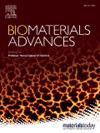原位压电诱导巨噬细胞M2极化调节雪旺细胞,减轻CCI大鼠神经性疼痛
IF 6
2区 医学
Q2 MATERIALS SCIENCE, BIOMATERIALS
Materials Science & Engineering C-Materials for Biological Applications
Pub Date : 2025-04-14
DOI:10.1016/j.bioadv.2025.214319
引用次数: 0
摘要
周围神经损伤常导致神经性疼痛,而神经性疼痛受巨噬细胞极化影响,影响雪旺细胞功能。生物电信号,特别是来自聚偏氟乙烯(PVDF)等压电材料的信号,在调节巨噬细胞极化中起着关键作用。在本研究中,我们证明PVDF的压电特性增强了缺氧巨噬细胞模型中的M2极化,这表明CD206 (M2标记物)表达增加,CD8 (M1标记物)表达减少。这种极化的转变与M2巨噬细胞中Arg-1和IL-10的分泌增强以及M1巨噬细胞中ROS、iNOS和TNF-α水平的降低有关。驱动这种极化转移的潜在机制涉及AMPK信号通路的激活。在体外,m2条件培养基显著促进雪旺细胞的增殖和迁移。在慢性坐骨神经收缩(CCI)大鼠模型中,PVDF治疗通过增加机械戒断阈值(MWT)和热戒断潜伏期(TWL)来改善疼痛敏感性。此外,PVDF处理降低了CD80/CD206 (M1/M2)比率,促进了抗炎环境,并增加了NF200/S100比率,表明轴突再生增强。RNA测序结果显示,与m2条件培养基共培养的雪旺细胞上调了细胞粘附分子(CAM)、Ca+信号通路和丝裂原活化蛋白激酶(MAPK),这是雪旺细胞再生和神经修复的关键信号通路。我们的研究结果表明,PVDF的压电特性为调节巨噬细胞极化和增强雪旺细胞活性提供了一种新的策略,为NP提供了潜在的治疗方法。本文章由计算机程序翻译,如有差异,请以英文原文为准。
In situ piezoelectricity induces M2 polarization of macrophages to regulate Schwann cells for alleviating neuropathic pain of CCI rats
Peripheral nerve injuries often lead to neuropathic pain (NP), which is influenced by macrophage polarization, impacting Schwann cell function. Bioelectric signals, particularly from piezoelectric materials like polyvinylidene fluoride (PVDF), play a pivotal role in modulating macrophage polarization. In this study, we demonstrate that PVDF's piezoelectric properties enhance M2 polarization during hypoxia macrophage model, as indicated by increased CD206 (M2 marker) expression and decreased CD8 (M1 marker). This shift in polarization is linked to enhanced secretion of Arg-1 and IL-10 from M2 macrophages, and reduced levels of ROS, iNOS, and TNF-α from M1 macrophages. The underlying mechanism driving this polarization shift involves the activation of the AMPK signaling pathway. In vitro, M2-conditioned medium significantly promoted Schwann cell proliferation and migration. In a chronic sciatic nerve constriction (CCI) rat model, PVDF treatment improved pain sensitivity, as shown by increased mechanical withdrawal threshold (MWT) and thermal withdrawal latency (TWL). Additionally, PVDF treatment reduced the CD80/CD206 (M1/M2) ratio, promoting an anti-inflammatory environment, and increased the NF200/S100 ratio, indicating enhanced axonal regeneration. RNA sequencing revealed that Schwann cells co-cultured with M2-conditioned medium upregulated Cell Adhesion Molecule (CAM), Ca+ signaling pathway, and Mitogen Activated Protein Kinases (MAPK), critical signal pathway for Schwann cell regeneration and nerve repair. Our findings suggest that PVDF's piezoelectric properties offer a novel strategy for modulating macrophage polarization and enhancing Schwann cell activity, providing a potential therapeutic approach for NP.
求助全文
通过发布文献求助,成功后即可免费获取论文全文。
去求助
来源期刊
CiteScore
17.80
自引率
0.00%
发文量
501
审稿时长
27 days
期刊介绍:
Biomaterials Advances, previously known as Materials Science and Engineering: C-Materials for Biological Applications (P-ISSN: 0928-4931, E-ISSN: 1873-0191). Includes topics at the interface of the biomedical sciences and materials engineering. These topics include:
• Bioinspired and biomimetic materials for medical applications
• Materials of biological origin for medical applications
• Materials for "active" medical applications
• Self-assembling and self-healing materials for medical applications
• "Smart" (i.e., stimulus-response) materials for medical applications
• Ceramic, metallic, polymeric, and composite materials for medical applications
• Materials for in vivo sensing
• Materials for in vivo imaging
• Materials for delivery of pharmacologic agents and vaccines
• Novel approaches for characterizing and modeling materials for medical applications
Manuscripts on biological topics without a materials science component, or manuscripts on materials science without biological applications, will not be considered for publication in Materials Science and Engineering C. New submissions are first assessed for language, scope and originality (plagiarism check) and can be desk rejected before review if they need English language improvements, are out of scope or present excessive duplication with published sources.
Biomaterials Advances sits within Elsevier''s biomaterials science portfolio alongside Biomaterials, Materials Today Bio and Biomaterials and Biosystems. As part of the broader Materials Today family, Biomaterials Advances offers authors rigorous peer review, rapid decisions, and high visibility. We look forward to receiving your submissions!

 求助内容:
求助内容: 应助结果提醒方式:
应助结果提醒方式:


